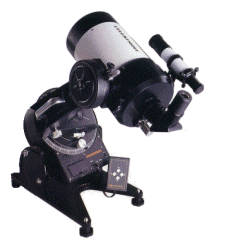
Indeed, it's not heavy. The C5+ weighs, all told, about 23 pounds (10 kg), not including whatever tripod you choose to put it on (or not). The tube itself weighs about 7 pounds (3 kg); the drive and mount about 9 pounds (4 kg), and the wedge another 7 pounds (3 kg). This makes it quite portable. It makes a difference when you have to nip and tuck your schedule here and there to scrape together a half an hour to do some observing. Not having to spend even 10 or 15 minutes to set up and tear down makes a big difference.
When I bought this telescope, back in July 1998, I decided to create this page because there were a lot of ETX pages out there, but there didn't seem to be many (if any) C5+ pages. Not that that's necessarily a bad thing, but I'd been thinking about doing this page anyway, and the scarcity made a convenient excuse.

After I had owned the scope for a year, I decided to give it a name: Opus. It's short and squat and waddly, and dressed in black and white. Plus it has a tendency to believe it can see things it plainly can't. All in all, a pretty appropriate nickname. Note the resemblance.
The C5+ is a Schmidt-Cassegrain telescope, or SCT, with a 5-inch aperture, made by Celestron (formerly Celestron International). At the time I bought it, it cost about $1,000 U.S., which was very nearly the same price as its larger brother, the C8. So why buy a smaller scope for the same amount of money? The answer, in a word, is portability. Even at 23 pounds, the C5+ was portable in a way that the C8 couldn't match.
It's interesting to note, however, that that wasn't always the intended appeal of the C5+. It began life as the C5 in 1971, just one year after Celestron had started the SCT craze with its C8. In the 1970s, dark skies were not nearly as rare as they are today, at the start of the 21st century, and one didn't necessarily have to drive out to the boondocks in order to observe effectively. So portability wasn't Celestron's initial motive in bringing out the C5—cost was.

But the C5 manufacturing process was dogged by unexpectedly high costs right from the beginning. Celestron had designed the C5 by essentially photo-reducing the C8 blueprints, down to using a scale version of the C8's dual axis, AC-powered spur-gear drive. The C5 also inherited the C8's orange tube, twin-arm fork, and uncoated OTA. Although this design resulted in lower materials costs, the tolerances for each part were correspondingly tighter as well.
The upshot was that it cost Celestron more to manufacture the C5 than the C8, even though they couldn't actually charge more for it. (I have a copy of the January 1983 issue of Sky and Telescope, in which a dealer advertises the C5 for $689 U.S., and the C8 for $777.) The C5, moreover, was viewed as a second scope rather than a beginner's scope; the C8 outsold the C5 by about a three-to-one margin. The higher cost meant a smaller profit margin, and when demand for telescopes burgeoned in the years before the return of Comet Halley, Celestron decided to drop the C5, in 1983, in order to concentrate on production of the C8. (It is perhaps worth remarking that the optical quality of mid- to late-1980s C8's is widely considered the lowest since its inception.)
Then, in December 1992, after a hiatus of 7 years, Celestron suddenly reintroduced the C5. What had happened in the intervening decade to prompt Celestron to bring back the unprofitable 5-inch SCT? First, nighttime skies had brightened considerably, due to the increased use of poorly designed light fixtures, especially around the mini-malls that had seemingly sprouted out of the ground in urban areas. This made a portable scope attractive in 1992 in a way that it wasn't in 1983.
Then, too, Celestron had completely redesigned the C5 series. Rather than simply scale the design of the workhorse C8 by a 5/8 factor, they designed the new C5 completely from scratch. The most immediately obvious difference was the clean white tube that graced the new telescope. Also, the twin-arm fork had been replaced by a one-armed mount that reduced its weight even further. Although this halved "fork" led to rumors of greatly compromised stability, in practice its damping time was not significantly longer than that of its predecessor.
The new C5 came in three flavors. First was the C5 Classic, which retained the AC-powered drive of the old orange-tubed model. Next was the C5+ (my model), which replaced the AC-powered drive with a DC-powered one, which could be run off a more convenient (and again, more portable) 9-volt battery. Also, it had a more robust 6x30 finder, rather than the spindly 5x24 of the Classic, and enhanced coatings on its optics. Finally, there was the C5 spotting scope.
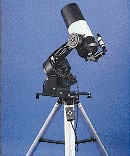
The C5+ received a favorable review in Sky and Telescope in 1993, which ensured its success for a while. By 1996, Celestron had seen enough of the C5's performance in the marketplace to reorganize its offerings. The C5 spotting scope remained as a separate product, but the C5 Classic and C5+ were merged into one. The new C5+ kept the DC drive and enhanced coatings, but the hand controller formerly standard was now made an option. The price dropped somewhat to compensate.
Two years later, however, Meade re-entered the portable scope market with its wildly popular ETX (which supposedly stands for Everyone's Telescope), a 3-1/2-inch Mak loosely modeled optically on the Questar 3.5, but with considerably more plastic and a much lower price—a mere $600 U.S. When Celestron didn't respond, Meade turned up the heat in early 1999 by adding goto to the ETX and maintaining the same low price.
That spelled the beginning of the end for the C5+. The ETX didn't have the aperture of the C5+, to be sure, but it had dual axis drives, amazing portability, and probably most importantly, it cost roughly $400 less. Celestron continued to advertise the C5+, but in the meantime it was busy developing a goto version of the C5+, called the Nexstar 5. Celestron finally announced the second discontinuation of the C5+ in May 1999, although the spotting scope version continued to exist. (This also meant the disappearance of the original C5+ manual.)
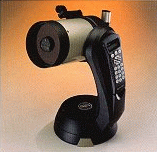
By the time that Celestron discontinued the C5+, rumors had already swirled for some time that Celestron would release a 5-inch goto SCT to compete with Meade's ETX line, which had recently come out with a 5-inch Maksutov-Cassegrain, with some Celestron reps being more tight-lipped than others. In the meantime, many dealers were dumping the last of their C5+ stock at significantly reduced prices.
In July, Celestron finally announced the Nexstar 5. Despite the difference in name, the OTA of the N5 shared a lot in its fit and finish with the Ultima 2000 8-inch SCT, which was released in 1996. The N5 was supposed to come out in September 1999, but in an unprecedented move, Celestron actually jumped the gun by a few weeks, releasing it in August with a street price of about $1,200 U.S.
Aside from the new appearance, which replaced the white tube of the C5+ with a soft gold satin, the most significant enhancement was the addition of a computerized hand controller to compete with Meade's ETX series. The N5 was a fully-equipped goto telescope: One could align against any two bright stars in the sky, and then dial up any position or object in its substantial database. To be sure, not all of the objects in the database were actually visible through the N5 from most sites, but Meade had forced Celestron's hand somewhat with the ETX's own oversized database.
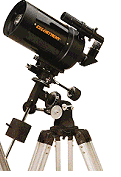
Along with the N5, Celestron also introduced an entry-level package for its 5-inch SCT, the G5. This scope mounted the SCT on the CG-3 German equatorial mount, and sold for a time for about $700 U.S. There was also a G3, Celestron's old C90 (a 90 mm Maksutov-Cassegrain) mounted on the same GEM. But the G5 and G3 were not to survive for long; the G3 was out of the market by late 2001, the G5 followed suit a year later, and Celestron retired (at least for the time being) its 90 mm OTA.
The N5 continued, along with the steadfast C5 spotter, until 2002, when it was discontinued, only to be replaced by the Nexstar 5i (which came out with the Nexstar 8i). The N5i added on an autoguider port, as well as an auxiliary port that allowed operation with Celestron's GPS accessory. The hand controller was also upgraded to make object selection somewhat more intelligent—no more would the telescope slew to objects below the local horizon.
A year later, Celestron introduced its Advanced Series of telescopes, incorporating its full range of optical designs—refractors, reflectors, SCTs, and MCTs—on the CG-4 and CG-5 German equatorial mounts. The C5-S, and the goto version, the C5-SGT, were the 5-inch SCT's representatives in the Advanced Series. Like the G5, however, these models were fated to a short lifetime, and Celestron discontinued them in 2005.
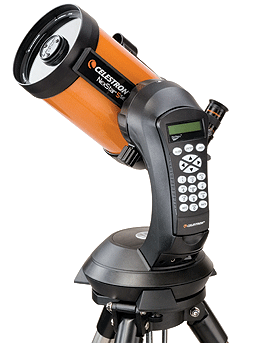
Celestron abruptly ended the run of the N5i, also in 2005. But this time, the interruption was only temporary, as in August 2006, the telescope that replaced the N5 was itself replaced in turn by the Nexstar 5 Special Edition (or N5 SE), which followed the introduction of the N8 SE just a year previously. Both telescopes sport an orange tube, but with an orange much more saturated than the models of old. Perhaps the most interesting enhancement was not directly visible: These telescopes allow one to align the telescope on any three bright objects in the sky, without needing to know which objects they are. Previous goto telescope could align on just two stars, but the stars had to be identified by the user. The hand controller was made even easier to use, with objects generally now appearing by their best-known names.

In 2008, Celestron added the Omni XLT 127, a midnight-blue version of the C5 OTA on the CG-4 German equatorial mount, for about $900 U.S., standing in some ways for the C5-S and C5-SGT in the Advanced Series. As the name implies, this telescope, like other recent editions, included the StarBright XLT coatings.
Through it all, the C5 has retained in essence its original optical design, and even the C5 spotter has never been discontinued since its reintroduction in 1992, although Celestron has updated its appearance: It took on a silver hue in 2002. With light pollution showing no signs of abating any time soon, putting dark observing sites at a premium, the continued success of Celestron's 5-inch SCT line seems assured.
Although I'm naturally interested in all versions of Celestron's 5-inch SCT, this site is devoted specifically to the C5+, the DC-powered model that Celestron sold between 1992 and 1999.
Copyright (c) 1998–2010 Brian Tung